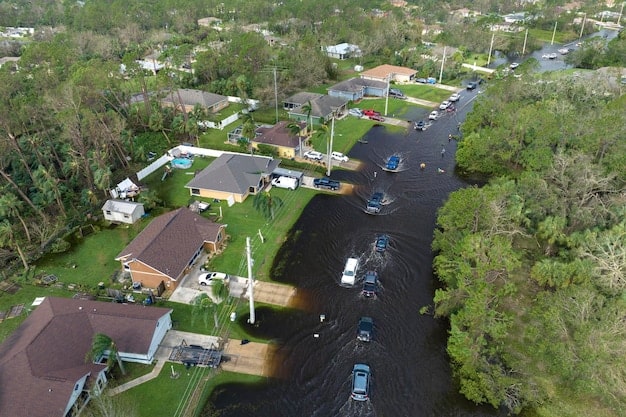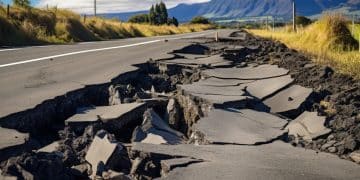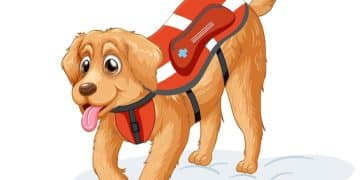Financial Preparedness: Protecting Your Assets After a US Disaster

Financial preparedness is crucial for protecting your assets before and after a disaster in the US, involving strategies for insurance, emergency funds, and securing important documents to mitigate potential financial losses.
In the face of unpredictable disasters, **financial preparedness: protecting your assets before and after a disaster in the US** becomes an essential part of your safety plan. Are you ready to ensure your financial well-being when the unexpected happens?
Understanding the Importance of Financial Preparedness
Disasters can strike at any time, leaving a trail of physical and emotional devastation. But beyond the immediate impact, they can also have severe financial consequences. Being financially prepared is not just about having money; it’s about having a plan to protect your assets and recover quickly.
Why Financial Preparedness Matters
Financial preparedness can significantly reduce the stress and hardship associated with disaster recovery. It provides a buffer to cover immediate expenses, repair damages, and rebuild your life.
It also ensures that you have access to important financial resources and documents when you need them most.
The High Cost of Disasters in the US
The United States experiences a wide range of natural disasters, from hurricanes and floods to wildfires and earthquakes. The economic toll of these events can be staggering, affecting individuals, families, and entire communities.
- Hurricanes: Often cause billions of dollars in damage, impacting coastal regions.
- Wildfires: Devastate homes and businesses, particularly in the western states.
- Floods: Can occur in any state, causing widespread property damage and displacement.
In conclusion, understanding the importance of financial preparedness involves recognizing the potential financial impact of disasters and proactively taking steps to mitigate those risks. By being prepared, you can protect your assets and ensure a smoother recovery process.
Creating an Emergency Fund for Disasters
An emergency fund is a cornerstone of financial preparedness. It’s a readily available source of cash that can be used to cover unexpected expenses, such as temporary housing, medical bills, or essential supplies. Establishing and maintaining an emergency fund is a crucial step in protecting your financial stability during and after a disaster.
How Much to Save
The general recommendation is to have at least three to six months’ worth of living expenses saved in an emergency fund. This amount can provide a financial cushion to cover basic needs if you lose your income or face significant unexpected costs.
Consider your personal circumstances when determining the ideal amount for your emergency fund. Factors such as job stability, health conditions, and insurance coverage can influence how much you need to save.
Where to Keep Your Emergency Fund
Your emergency fund should be kept in a safe and accessible location. High-yield savings accounts or money market accounts are good options because they offer both security and liquidity.
- High-Yield Savings Accounts: Offer competitive interest rates and easy access to your funds.
- Money Market Accounts: Similar to savings accounts but may offer slightly higher rates and check-writing privileges.
- Avoid Risky Investments: Keep your emergency fund separate from investments that could lose value in a downturn.
In conclusion, creating an emergency fund is a vital step in financial preparedness. By determining the right amount to save and choosing a secure and accessible location, you can ensure that you have the resources you need to weather a financial storm.
Reviewing and Updating Your Insurance Coverage
Insurance is a critical component of financial preparedness, providing a safety net to cover damages and losses resulting from disasters. Regularly reviewing and updating your insurance coverage ensures that you have adequate protection for your home, belongings, and other assets.
Homeowners Insurance
Homeowners insurance protects your home and personal property from various perils, such as fire, windstorms, and theft. It’s essential to understand what your policy covers and whether it includes specific disaster-related damages.
Consider purchasing additional coverage for risks that are not included in your standard policy, such as flood insurance or earthquake insurance, depending on your location and the types of disasters you are most likely to face.
Flood Insurance
Standard homeowners insurance policies typically do not cover flood damage. If you live in an area prone to flooding, purchasing a separate flood insurance policy through the National Flood Insurance Program (NFIP) or a private insurer is crucial.
- NFIP: Offers flood insurance to homeowners, renters, and business owners in participating communities.
- Private Flood Insurance: May provide broader coverage or higher limits than NFIP policies.
- Assess Your Risk: Determine your flood risk by checking FEMA flood maps and consulting with insurance professionals.

In conclusion, regularly reviewing and updating your insurance coverage is an essential part of financial preparedness. Ensure that you have adequate protection for your home, belongings, and other assets by understanding your policy and considering additional coverage for specific disaster-related risks.
Securing and Backing Up Important Documents
Important documents, such as insurance policies, bank statements, and identification cards, are essential for accessing financial resources and filing claims after a disaster. Securing and backing up these documents ensures that you have access to them when you need them most.
Creating a Digital Backup
Creating digital copies of your important documents is a convenient way to ensure that you have access to them even if the originals are lost or damaged. Scan or photograph your documents and store them securely online.
Use cloud storage services or encrypted external hard drives to protect your digital backups from unauthorized access.
Storing Physical Copies Safely
Store physical copies of your important documents in a waterproof and fireproof safe or container. Keep the safe in a secure location that is easily accessible in case of an emergency.
- Waterproof Container: Protects documents from water damage caused by floods or leaks.
- Fireproof Safe: Shields documents from fire and extreme heat.
- Accessibility: Ensure that you can quickly access the safe or container in an emergency.
In conclusion, securing and backing up important documents is a crucial step in financial preparedness. By creating digital backups and storing physical copies safely, you can ensure that you have access to the information you need to recover from a disaster.
Developing a Communication and Evacuation Plan
In the chaos of a disaster, clear communication and a well-defined evacuation plan are crucial for ensuring the safety of your family and protecting your assets. Creating a comprehensive plan can minimize confusion and help you respond quickly and effectively.
Establishing a Communication Strategy
Establish a communication strategy that includes multiple ways to stay in touch with family members and emergency contacts. Designate a meeting place in case you become separated during an evacuation.
Consider using communication tools such as group text messages, social media, or emergency alert apps to stay informed and connected.
Creating an Evacuation Checklist
Develop an evacuation checklist that includes essential items to take with you, such as medications, personal documents, and emergency supplies. Practice your evacuation plan regularly to ensure that everyone knows what to do.
- Medications: Carry a sufficient supply of prescription and over-the-counter medications.
- Personal Documents: Include identification cards, insurance policies, and financial records.
- Emergency Supplies: Pack a first-aid kit, flashlight, batteries, and non-perishable food.
In conclusion, developing a communication and evacuation plan is an essential part of financial preparedness. By establishing a clear communication strategy and creating an evacuation checklist, you can ensure the safety of your family and protect your assets during a disaster.
Accessing Financial Assistance After a Disaster
After a disaster, various forms of financial assistance may be available to help you recover and rebuild. Understanding the different types of assistance and how to access them is crucial for getting back on your feet.
Federal Disaster Assistance
The Federal Emergency Management Agency (FEMA) provides disaster assistance to individuals, families, and businesses affected by major disasters. This assistance may include grants for temporary housing, home repairs, and other essential needs.
To apply for FEMA assistance, you must register online or by phone and provide documentation of your identity, address, and damages.
Small Business Administration (SBA) Loans
The Small Business Administration (SBA) offers disaster loans to homeowners, renters, and businesses to help them recover from physical and economic damages. These loans may be used to repair or replace damaged property, inventory, and equipment.
- Home Disaster Loans: Available to homeowners and renters to repair or replace damaged property.
- Business Disaster Loans: Available to businesses of all sizes to cover losses and expenses.
- Economic Injury Disaster Loans (EIDL): Available to small businesses and non-profit organizations to help meet financial obligations.
In conclusion, accessing financial assistance after a disaster is crucial for your recovery. By understanding the different types of assistance available and how to apply for them, you can get the financial support you need to rebuild your life.
Maintaining Long-Term Financial Resilience
Financial preparedness is not a one-time event but an ongoing process. Maintaining long-term financial resilience requires continuous effort to review, update, and improve your financial strategies. Here’s a look at what is involved.
Regularly Reviewing Your Finances
Make it a habit to review your finances at least once a year. Check your emergency fund, insurance coverage, and important documents to ensure they are up-to-date.
Adjust your financial plan as needed to reflect changes in your income, expenses, and risk tolerance.
Investing in Education and Training
Enhance your financial literacy by attending workshops, reading books, or taking online courses on disaster preparedness and financial management. This knowledge will empower you to make informed decisions and protect your assets.
- Financial Literacy Workshops: Provide practical tips and strategies for managing your finances.
- Online Courses: Offer flexible learning options on various financial topics.
- Professional Advice: Consult with a financial advisor for personalized guidance and support.
In conclusion, maintaining long-term financial resilience involves continuous effort to review, update, and improve your financial strategies. By staying informed and proactive, you can ensure that you are well-prepared to face any financial challenges that may come your way.
| Key Point | Brief Description |
|---|---|
| 💰 Emergency Fund | Save 3-6 months of living expenses in a liquid account. |
| 🛡️ Insurance Review | Ensure your home, flood, and other insurances are up-to-date. |
| 📄 Secure Documents | Digitize and store copies of important documents securely. |
| 📞 Communication Plan | Have a clear communication and evacuation strategy for emergencies. |
Frequently Asked Questions (FAQ)
▼
Aim to save at least three to six months’ worth of living expenses in an easily accessible account. Tailor the amount to your personal circumstances and risk tolerance.
▼
Consider homeowners insurance, flood insurance (if applicable), and other relevant coverage for specific disaster-related risks in your area. Always review your policies annually.
▼
Keep copies in a waterproof and fireproof safe or container. Digitize and store copies securely online, using cloud storage services or encrypted external hard drives.
▼
Establish a reliable communication strategy, including multiple contact methods like group texts or emergency alert apps. Designate a meeting place if separated during evacuation.
▼
Explore federal disaster assistance through FEMA and SBA disaster loans for homeowners, renters, businesses. Eligibility requirements and application processes vary, so prepare documentation.
Conclusion
Being financially prepared for a disaster requires thought and effort but is critical for protecting your assets and ensuring a smoother recovery. By developing a financial preparedness plan, you’re investing in your future security and your peace of mind.





